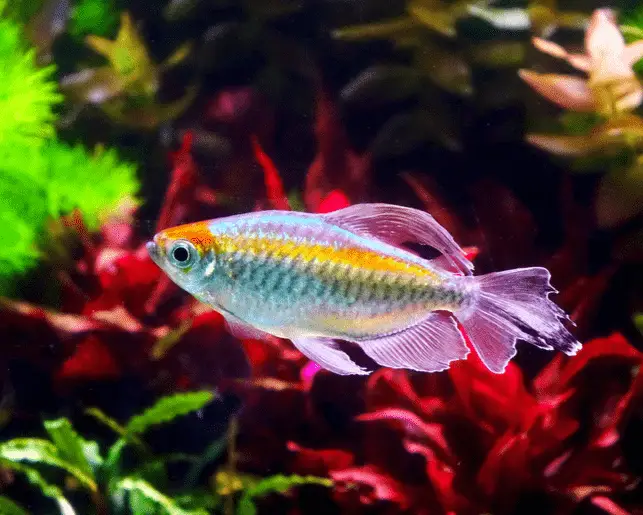Tetras are one of the most popular aquarium fish as they are easy to care for, and they come in a variety of colors and patterns. Like many fish, they are oviparous, meaning they lay eggs instead of giving birth to live young. However, it can be challenging to tell if a female tetra is carrying eggs because they don’t have a visible pregnancy like mammals do. In this blog post, we’ll discuss some signs to look out for that may indicate a female tetra is carrying eggs.
The first thing to understand about tetra pregnancy is that it can be difficult to detect. Unlike some other species of fish, tetras do not have a prominent belly when they are carrying eggs. Instead, the signs of pregnancy are more subtle.
How Can You Tell If A Tetra Is Carrying Eggs?
Changes in Behavior: One of the most common signs of pregnancy in tetras is a change in behavior. Pregnant fish may become more reclusive and spend more time hiding in plants or decorations. They may also become less active and swim more slowly than usual.
Changes in Appearance: While tetras do not have a visible belly when pregnant, you may notice other changes in their appearance. Pregnant fish may appear rounder than usual, especially around the midsection. Their colors may also become brighter and more vibrant.
Nesting Behavior: Some species of tetra, such as the Black Neon Tetra, are known to exhibit nesting behavior when they are pregnant. This can include building a nest using plants or other materials in the aquarium.
Egg Laying: When tetras are ready to lay their eggs, they may become more active and start swimming more quickly than usual. You may also notice them rubbing their bodies against plants or decorations in the aquarium.

What Should You Do If my Tetra is Carrying Eggs?
If you think your female tetra is carrying eggs or is in the “gravid” stage, there are several things you can do to help ensure the successful hatching and development of the eggs:
Provide suitable spawning sites:
Tetras prefer to lay their eggs on plants, so having a dense and varied selection of aquatic plants in the aquarium is crucial. Plants such as Java Moss, Java Fern, and Hornwort are ideal as they provide a lot of surface area for the eggs to attach to. Floating plants like Water Sprite can also be helpful, as they provide cover and shade for the eggs and fry.
In addition to plants, tetras also like to lay their eggs on substrate such as sand or gravel. A fine-grain substrate is ideal, as it allows the eggs to settle and provides a suitable environment for the fry to hatch.
Separate the breeding pair:
Some tetra species can be territorial during spawning, so it may be necessary to separate the breeding pair from the rest of the fish in the aquarium. This can be done by using a breeding box or separate tank, which will also help to protect the eggs and fry from other fish in the aquarium.
Some isolation tanks have a separate compartment for the eggs, like this one. These tanks are ideal for tetras, as the eggs have a safe space to mature where the mother and other killifish can’t eat them.
Adjust water parameters:
Before spawning, it’s important to ensure that the water quality is optimal. The temperature should be kept between 74 and 82 degrees Fahrenheit, and the pH should be slightly acidic at around 6.5 to 7.0. Regular water changes should also be carried out to maintain good water quality.
Provide suitable food:
During the gravid period, it’s important to provide the female with a varied and nutritious diet to support the development of the eggs. Offer high-quality flake or pellet food, as well as live or frozen foods such as brine shrimp, daphnia, or bloodworms.
Monitor the eggs:
Once the eggs have been laid, monitor them closely to ensure they are developing properly. Remove any unfertilized or diseased eggs to prevent them from contaminating the water.

What To Do When A Tetra Gives Birth.
Once the eggs have been laid, it’s important to take steps to ensure the survival of the fry. Here are some tips on what to do when tetras lay eggs:
- Protect the Eggs: After laying the eggs, the tetras will typically abandon them. It’s important to protect the eggs from other fish in the aquarium, as they may view them as a food source. One way to do this is to place a mesh or breeding net around the area where the eggs have been laid.
- Monitor Water Quality: In the first few days after the eggs are laid, it’s important to monitor the water quality closely. The ammonia and nitrite levels can increase quickly as the eggs begin to hatch, so regular water changes may be necessary to maintain good water quality.
- Feed the Fry: Once the eggs hatch, the fry will need to be fed small amounts of food several times a day. Infusoria or liquid fry food can be used for the first few days, and then you can gradually move on to small live foods such as newly hatched brine shrimp or micro worms.
- Provide Cover: The fry will need a safe place to hide and grow, so provide plenty of cover in the form of plants and decorations. You can also use a breeding box or separate tank to keep the fry separate from the rest of the fish in the aquarium.
- Gradually Introduce to Main Tank: As the fry grow and become stronger, you can gradually introduce them to the main tank. It’s important to do this slowly, as other fish in the aquarium may view them as food. Keep a close eye on the fry as they integrate into the main tank, and be prepared to separate them if necessary.
This short video shows you signs to indicate your tetra is about to lay eggs.
Conclusion.
In conclusion, it can be challenging to tell if a female tetra is carrying eggs, but there are some signs to look out for that may indicate the presence of eggs, as mentioned in this article.
If you notice any of these signs in your tetra, it is possible that she is pregnant. However, it is important to note that not all tetras will exhibit these behaviors, and some may be more subtle than others.
By observing these signs and being familiar with the breeding habits of tetras, you can increase your chances of successfully breeding and raising these beautiful fish in your aquarium.
Further Articles about Tetras:
Why does my tetra stay at the bottom of the tank?

